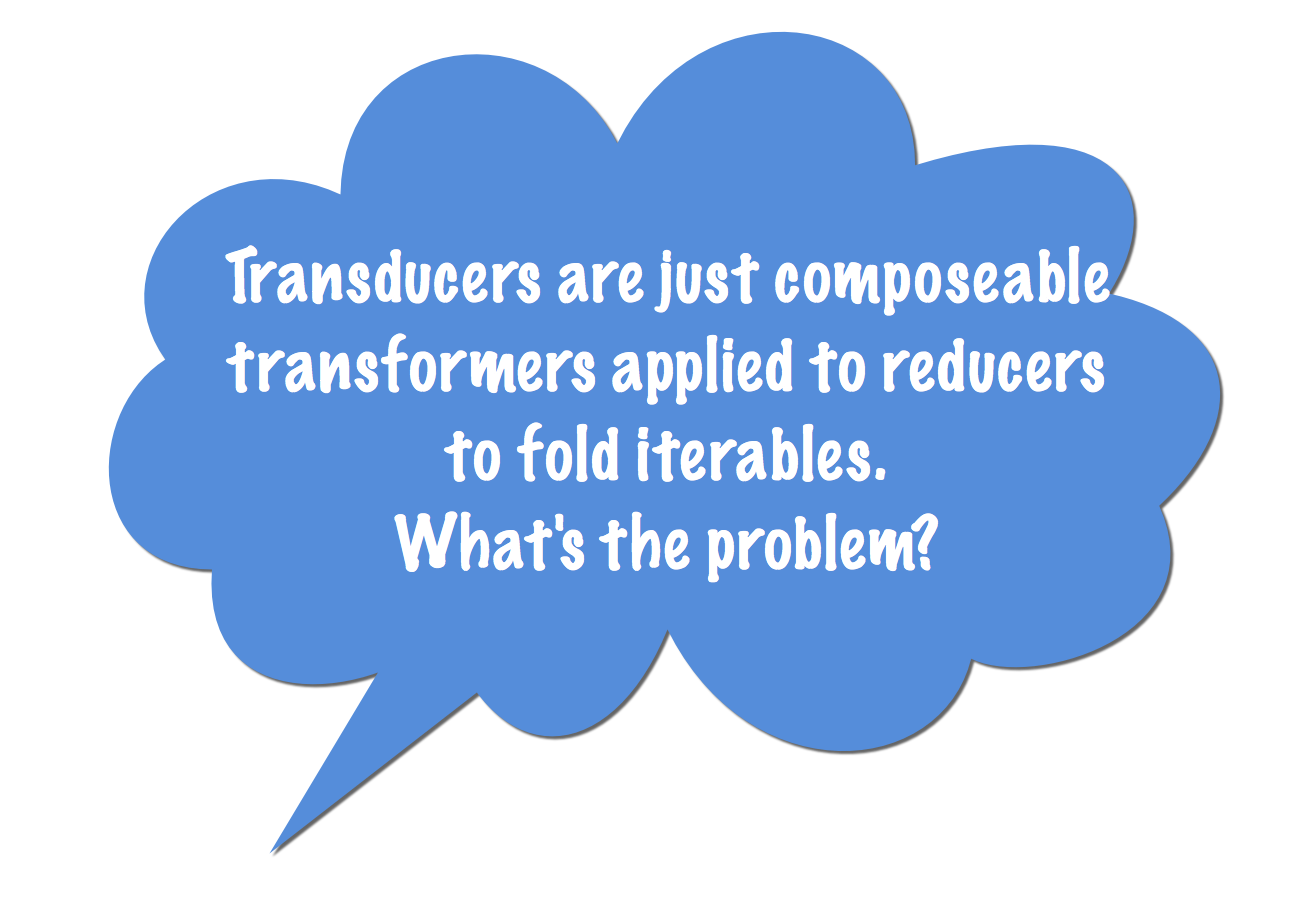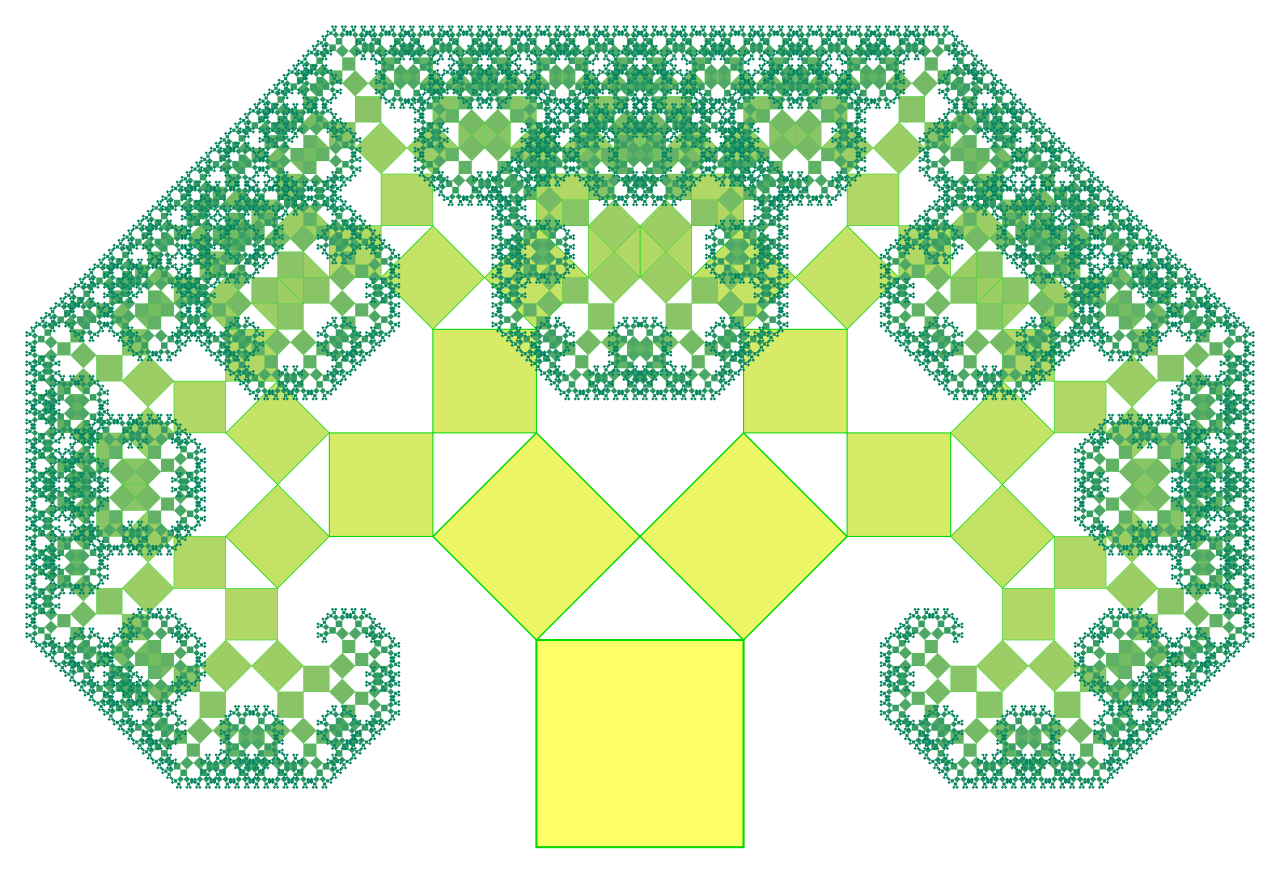[译]什么是 Transducer
什么是 Transducer
本文转载自:众成翻译
译者:明非
在使用迭代器编写高可组合代码中,我们看到staged approach的数据转换方法是被分解的,但是复制了整个数据集。而single pass approach更有效率,但代码是混乱不清晰的。
现在我们来看一个有趣的转换方法来实现代码的可组合,而不会导致内存损失,transducer。
我们先来看看 reducing:
reducers
reducer函数接收一个累积值(译者注:一个通过迭代后累积成的变量)和一个值,它将这个值加入到累积值中。比如,如果 [1,2,3] 是一个 累积值,4 是将要被添加到累积值的一个值, 执行 (acc, val) => acc.concat([val])通过这个reducer将返回[1,2,3,4]:
const acc = [1, 2, 3];
const val = 4;
const reducer = (acc, val) => acc.concat([val]);
reducer(acc, val)
///=> 1, 2, 3, 4
(acc, val) => acc.concat([val])是一个 reducer,它可以将一个数组和一个值连接。
(acc, val) => acc.add(val)也是一个同样的 reducer,.add是将一个值插入到这个累积值数组的后面。它适用于任何有.add事件,并且执行.add事件后返回自身的对象,比如 Set.prototype.add:
const acc = new Set([1, 2, 3]);
const val = 4;
const reducer = (acc, val) => acc.add(val);
reducer(acc, val)
///=> Set{1, 2, 3, 4}
这里有一个函数,使用我们的之前创建的reducer,可以让任何可迭代的数据变成数组。
const toArray = iterable => {
const reducer = (acc, val) => acc.concat([val]);
const seed = [];
let accumulation = seed;
for (value of iterable) {
accumulation = reducer(accumulation, value);
}
return accumulation;
}
toArray([1, 2, 3])
//=> [1, 2, 3]
我们可以创建一个reduction函数,将reducer和seed(初始值)变量作为参数。
const reduce = (iterable, reducer, seed) => {
let accumulation = seed;
for (const value of iterable) {
accumulation = reducer(accumulation, value);
}
return accumulation;
}
reduce([1, 2, 3], (acc, val) => acc.concat([val]), [])
//=> [1, 2, 3]
值得庆幸的是,JavaScript正在逐渐发展成一个编写函数的惯例,如reduce方法一般先传一个reducer当做参数。根据JavaScript Allongé编码风格,我们可以这样写:
const reduceWith = (reducer, seed, iterable) => {
let accumulation = seed;
for (const value of iterable) {
accumulation = reducer(accumulation, value);
}
return accumulation;
}
reduce([1, 2, 3], (acc, val) => acc.concat([val]), [])
//=> [1, 2, 3]
// becomes:
reduceWith((acc, val) => acc.concat([val]), [], [1, 2, 3])
//=> [1, 2, 3]
在JavaScript中,数组有一个.reduce方法,它的行为与reduce和reduceWith比较像:
[1, 2, 3].reduce((acc, val) => acc.concat([val]), [])
//=> [1, 2, 3]
现在,(acc, val) => acc.concat([val]) 会产生大量新的数组,占用内存,我们可以使用(acc,val) => { acc.push(val);return acc;} .(1)
无论哪种方式,我们都能获得的是将一个值加到数组最后面的reducer。我们给这个方法一个名字:
const arrayOf = (acc, val) => { acc.push(val); return acc; };
reduceWith(arrayOf, [], [1, 2, 3])
//=> [1, 2, 3]
这有另外一个reducer:
const sumOf = (acc, val) => acc + val;
reduceWith(sumOf, 0, [1, 2, 3])
//=> 6
我们可以编写一个reducer,它将可迭代的数据(如数组)通过reduce转变为另一种类型(如数字)。(译者注:像这一个reducer,累计值其实是传入reduceWith的可迭代数据相加所得的数,reducer的第一个参数并非必须是一个数组)
装饰reducer
使用JavaScript写一个返回值是一个函数的函数比较容易。这里有一个reducer:
const joinedWith =
separator =>
(acc, val) =>
acc == '' ? val : `${acc}${separator}${val}`;
reduceWith(joinedWith(', '), '', [1, 2, 3])
//=> "1, 2, 3"
reduceWith(joinedWith('.'), '', [1, 2, 3])
//=> "1.2.3"
JavaScript编写以函数为参数的函数也很容易。
在JavaScript中,装饰器函数可以接受一个函数作为参数,然后返回一个对传过来的函数进行包装的函数。比如,这个方法获取一个binaryFn,然后将函数包装成第二个参数加1的另外一个函数。
const incrementSecondArgument =
binaryFn =>
(x, y) => binaryFn(x, y + 1);
const power =
(base, exponent) => base ** exponent;
const higherPower = incrementSecondArgument(power);
power(2, 3)
//=> 8
higherPower(2, 3)
//=> 16
power被装饰后,指数(第二个参数)+1,返回一个方法,我们将它赋值给higherPower。因此,调用higherPower(2, 3)其实是调用了power(2, 4)。当然,我们一直在使用binaryFn。这里的 reducer 是 binaryFn。我们可以装饰它吗?当然!
reduceWith(incrementSecondArgument(arrayOf), [], [1, 2, 3])
//=> [2, 3, 4]
const incremented =
iterable =>
reduceWith(incrementSecondArgument(arrayOf), [], iterable);
incremented([1, 2, 3])
//=> [2, 3, 4]
mappers
上面的代码,我们生成了一个mapper函数,他接收可迭代的集合,返回一个原数据基础上,每一个数据+1的集合。但是我们当然要做的不仅仅是把每个数据增加1。让我们单独看一下incrementSecondArgument:
const incrementSecondArgument =
binaryFn =>
(x, y) => binaryFn(x, y + 1);
当我们装饰reducers的时候,多起一些有意义的名字。
const incrementValue =
reducer =>
(acc, val) => reducer(acc, val + 1);
现在,我们可以看到incrementValue获得了一个reducer作为参数,然后返回一个第二个参数+1的reducer。我们可以提取出val+1当做一个方法为一个参数:
const map =
fn =>
reducer =>
(acc, val) => reducer(acc, fn(val));
const incrementValue = map(x => x + 1);
reduceWith(incrementValue(arrayOf), [], [1, 2, 3])
//=> [2, 3, 4]
虽然看起来不太习惯这样写,一个函数需要函数作为参数,然后返回一个参数是函数的函数(译者注:这的确很绕,看一看上面那段代码应该可以明白)。我们可以用map(x => x + 1)替换incrementValue,可以写成:
reduceWith(map(x => x + 1)(arrayOf), [], [1, 2, 3])
//=> [2, 3, 4]
因为我们的map装饰器可以装饰任何reducer,我们可以将1-3变成一个字符串或者进行累加:
reduceWith(map(x => x + 1)(joinedWith('.')), '', [1, 2, 3])
//=> "2.3.4"
reduceWith(map(x => x + 1)(sumOf), 0, [1, 2, 3])
//=> 9
直到这里,我们可以计算1到10的数字的平方和是多少:
const squares = map(x => power(x, 2));
const one2ten = [1, 2, 3, 4, 5, 6, 7, 8, 9, 10];
reduceWith(squares(sumOf), 0, one2ten)
//=> 385
过滤器
我们看我们写的第一个reducer:
const arrayOf = (acc, val) => { acc.push(val); return acc; };
reduceWith(arrayOf, 0, one2ten)
//=> [1, 2, 3, 4, 5, 6, 7, 8, 9, 10]
我们怎么滤掉小于等于5的数字,获得一个所有数都大于5的数组。这很简单:
const bigUns = (acc, val) => {
if (val > 5 ) {
acc.push(val);
}
return acc;
};
reduceWith(bigUns, [], one2ten)
//=> [6, 7, 8, 9, 10]
当然,我们可以通过之前写的squares方法将大于5的数进行平方:
reduceWith(squares(bigUns), [], one2ten)
//=> [9, 16, 25, 36, 49, 64, 81, 100]
显然,这并不是我们想要的!我们想要进行_平方_计算的是大于5的数,而这种方法返回的是平方后大于5的数。我们想先选出数字来,然后在进行平方。这很容易完成,我们想要的装饰器是选择数字,我们可以使用它来装饰reducer:
reduceWith(squares(arrayOf), [], one2ten)
//=> [1, 4, 9, 16, 25, 36, 49, 64, 81, 100]
const bigUnsOf =
reducer =>
(acc, val) =>
(val > 5) ? reducer(acc, val) : acc;
reduceWith(bigUnsOf(squares(arrayOf)), [], one2ten)
//=> [36, 49, 64, 81, 100]
bgUnsOf是相当具体的。我们可以将它写成map一样,我们来提取判定函数:
reduceWith(squares(arrayOf), [], one2ten)
//=> [1, 4, 9, 16, 25, 36, 49, 64, 81, 100]
const filter =
fn =>
reducer =>
(acc, val) =>
fn(val) ? reducer(acc, val) : acc;
reduceWith(filter(x => x > 5)(squares(arrayOf)), [], one2ten)
//=> [36, 49, 64, 81, 100]
这样我们就可以制作各种过滤器。比如:
reduceWith(filter(x => x % 2 === 1)(arrayOf), [], one2ten)
//=> [1, 3, 5, 7, 9]
有了这一切,从1到10的奇数的平方和是:
reduceWith(filter(x => x % 2 === 1)(squares(sumOf)), 0, one2ten)
//=> 165
“转换器”和组合
其他的编程社区给这种把参数转换成其他东西的函数起了个名字:他们称之为“转换器”。我们所说的装饰器是一种特殊的转换器,因此,如果有人谈到“转换器”是把一个reducer转换成另外一个reducer,就像我们之前所看到的,我们使用了一个叫“装饰器”的东西,将reducer添加了一些额外的功能,比如 map 或者 filter。
之前我们讨论过的mapper和filters都是转换器。在这种编程模式的下,转换器的一个基本特征是它将多个转换器组合成一个新的转换器。复习一下,这里有一个方法组合任何两个函数:
const plusFive = x => x + 5;
const divideByTwo = x => x / 2;
plusFive(3)
//=> 8
divideByTow(8)
//=> 4
const compose2 =
(a, b) =>
(...c) =>
a(b(...c));
const plusFiveDividedByTwo = compose2(divideByTwo, plusFive);
plusFiveDividedByTwo(3)
//=> 4
为什么说转换器合并成一个新的转换器?就是说,我们使用compose2组合了任何两个转换器,得到一个新的转换器来转换一个reducer。所以:
const squaresOfTheOddNumbers = compose2(
filter(x => x % 2 === 1),
squares
);
reduceWith(squaresOfTheOddNumbers(sumOf), 0, one2ten)
//=> 165
squaresOfTheOddNumbers转换器是由filter和mapper合并而来。
组装装饰器,让我们将复杂和高度耦合的代码分解成有意义的更小的单元。
通过转换器组合
刚刚我们知道了组合两个转换器,我们是否可以组合任意数量的函数呢?这里有一个可行的reduction:
我们开始将之前的 compose2重写成转换器,compositionOf:
`const compositionOf = (acc, val) => (...args) => val(acc(...args));`
我们可以写一个 compose 来获取reduction的参数。
const compose = (...fns) =>
reduceWith(compositionOf, x => x, fns);
所以,什么是transducer呢?
将reduction写成这种样式:
`reduceWith(squaresOfTheOddNumbers(sumOf), 0, one2ten)`
可以发现,执行这个方法时的参数分成了四个元素:一个reducer转换器(或许是一个转换器组合),一个seed,一个可迭代数据。如果我们把它们分为单独的参数,我们得到:2
const transduce = (transformer, reducer, seed, iterable) => {
const transformedReducer = transformer(reducer);
let accumulation = seed;
for (const value of iterable) {
accumulation = transformedReducer(accumulation, value);
}
return accumulation;
}
transduce(squaresOfTheOddNumbers, sumOf, 0, one2ten)
//=> 165
读到这里你可以了解到:reducer 是你将要传递给.reduce的函数——他需要一个数据集和一个新的数据,返回一个新的数据集。转换器是一个将reducer转换成另外一个reducer的函数。和一个transducer(“转换器”加“reducer”,明白了吗?)是一个参数为一个转换器、一个reducer、一个seed外加一个可迭代数据,并通过reduce变成一个值。
transducer模式的优雅之处在于转换器自然组合生产新的转换器。所以我们可以连接尽可能多的transformer,最终得到一个转换过的reducer,我们只需要迭代一次集合。我们不需要为集合创建副本,也不需要多次迭代数据。
Transducer的概念来自Clojure编程社区,但是您可以发现,它在JavaScript也非常实用,并且使用JavaScript实现起来非常简单。
那么,如果有人问我们什么是“transducer”,我们现在可以回复:

最后
我们编写transducer的代码是非常紧凑和优雅的:
const arrayOf = (acc, val) => { acc.push(val); return acc; };
const sumOf = (acc, val) => acc + val;
const setOf = (acc, val) => acc.add(val);
const map =
fn =>
reducer =>
(acc, val) => reducer(acc, fn(val));
const filter =
fn =>
reducer =>
(acc, val) =>
fn(val) ? reducer(acc, val) : acc;
const compose = (...fns) =>
fns.reduce((acc, val) => (...args) => val(acc(...args)), x => x);
const transduce = (transformer, reducer, seed, iterable) => {
const transformedReducer = transformer(reducer);
let accumulation = seed;
for (const value of iterable) {
accumulation = transformedReducer(accumulation, value);
}
return accumulation;
}
它涵盖了我们目前用于数组所使用的所有情况:.map,.filter和.reduce,组合后的transducer不会产生数据集的任何副本。可以使用transducer来实现一些常用的方法(比如.find功能),产出一个JavaScript库。
其他的库有这样搞的:transduce函数假定数据集是可迭代的,它要求我们提供seed和reducer。在大多数情况下,同一类型的所有集合的种子和reducer函数是相同的。
当然,OOP已经使用多态的解决了这个问题。类库提供了方法,所以如果你调用正确的方法,你会得到正确的返回值。Production-class libraries 给我们提供了可视化的集合类型来让transducer的操作更加优雅。
但是,这足以掌握transducer模式,再次拥抱语言把函数当做一等公民的美好远景。
transducer方法来跟踪用户转换
(请参阅使用迭代器编写高度可编写的代码。)
const logContents = `1a2ddc2, 5f2b932
f1a543f, 5890595
3abe124, bd11537
f1a543f, 5f2b932
f1a543f, bd11537
f1a543f, 5890595
1a2ddc2, bd11537
1a2ddc2, 5890595
3abe124, 5f2b932
f1a543f, 5f2b932
f1a543f, bd11537
f1a543f, 5890595
1a2ddc2, 5f2b932
1a2ddc2, bd11537
1a2ddc2, 5890595`;
const asStream = function * (iterable) { yield * iterable; };
const lines = str => str.split('\n');
const streamOfLines = asStream(lines(logContents));
const datums = str => str.split(', ');
const datumize = map(datums);
const userKey = ([user, _]) => user;
const pairMaker = () => {
let wip = [];
return reducer =>
(acc, val) => {
wip.push(val);
if (wip.length === 2) {
const pair = wip;
wip = wip.slice(1);
return reducer(acc, pair);
} else {
return acc;
}
}
}
const sortedTransformation =
(xfMaker, keyFn) => {
const decoratedReducersByKey = new Map();
return reducer =>
(acc, val) => {
const key = keyFn(val);
let decoratedReducer;
if (decoratedReducersByKey.has(key)) {
decoratedReducer = decoratedReducersByKey.get(key);
} else {
decoratedReducer = xfMaker()(reducer);
decoratedReducersByKey.set(key, decoratedReducer);
}
return decoratedReducer(acc, val);
}
}
const userTransitions = sortedTransformation(pairMaker, userKey);
const justLocations = map(([[u1, l1], [u2, l2]]) => [l1, l2]);
const stringify = map(transition => transition.join(' -> '));
const transitionKeys = compose(
stringify, justLocations, userTransitions, datumize
);
const countsOf =
(acc, val) => {
if (acc.has(val)) {
acc.set(val, 1 + acc.get(val));
} else {
acc.set(val, 1);
}
return acc;
}
const greatestValue = inMap =>
Array.from(inMap.entries()).reduce(
([wasKeys, wasCount], [transitionKey, count]) => {
if (count < wasCount) {
return [wasKeys, wasCount];
} else if (count > wasCount) {
return [new Set([transitionKey]), count];
} else {
wasKeys.add(transitionKey);
return [wasKeys, wasCount];
}
}
, [new Set(), 0]
);
greatestValue(
transduce(transitionKeys, countsOf, new Map(), streamOfLines)
)
//=>
[
"5f2b932 -> bd11537",
"bd11537 -> 5890595"
],
4
进一步阅读
笔记
(acc, val) => (acc.push(val), acc)在语义是令人赏心悦目的,但是不经常使用逗号操作符会有些不习惯,最好避免在生产代码中。↩- 在一些编程社区中,对于字符有很强的保护意识,所以tarnsformer缩写为xform甚至xf。如果你看到像
(xf,reduce,seed,coll)或xf((val,acc) => acc) -> (val,acc) => acc不要惊讶。这篇文章没有这么写,我们在生产代码中也没有像xf或xform这样的名称。↩
版权声明

本博客文章均为 范明非 原创或翻译,采用知识共享 署名-非商业性使用-相同方式共享 4.0 国际 许可协议进行许可。
原文地址: https://fanmingfei.com/posts/What_is_Transducer.html

